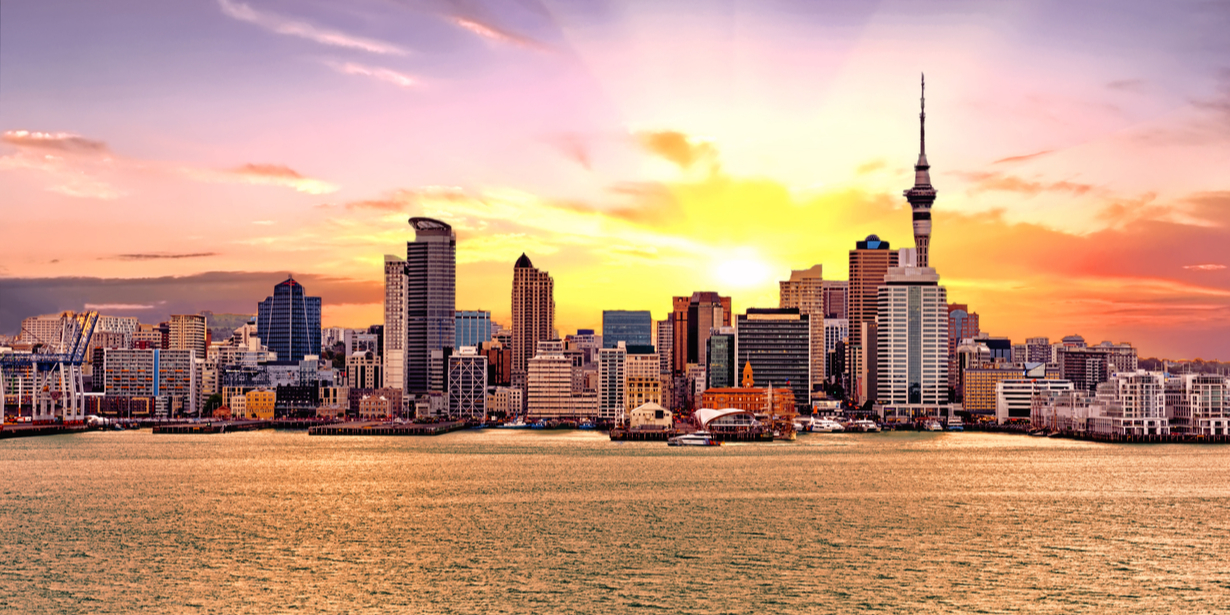Image: Shutterstock
It’s an age-old phenomenon, the harbour city that turns its back on the water. Until recently downtown Auckland seemed obstinately ignorant of the loveliness of the harbour at the bottom of the main street. The ports had historically fenced off much of it for loading and unloading cargo, and the rest of the downtown waterfront strip was an assortment of ferry berths, old warehouses and businesses supplying the maritime industry. Office towers ogled the harbour from on high, but getting close to the water while at street level was an almost impossible task.
Now things have changed dramatically. Thanks to a succession of smart redesign projects, the city feels more connected to the harbour than ever before. The latest phase of the city’s dazzling waterfront reinvention is scheduled to open in December 2020 to celebrate the America’s Cup: a generous new plaza near the foot of Queen Street will be studded with native Pōhutukawa trees and seating areas that offer spaces for contemplation of the harbour in one of the busiest parts of town.
On Quay Street, the main harbourside boulevard, footpaths are being widened, cycle lanes added, and vehicular traffic reduced. You can now walk for almost a kilometre beside the water without having to pause for passing cars.
The evocative Māori name for Auckland’s Waitematā Harbour translates as ‘waters of obsidian’, a reference to the way its glassy surface can resemble volcanic obsidian rock – an apt description in a location shaped by volcanic explosions, the last of which occurred a mere 600 years ago. The harbour’s reputation as a great place to fish was recognised for centuries by local Māori.
When English settlers arrived, they quickly understood that this calm, sheltered anchorage was infinitely preferable to the wildness of the west coast as a place to drop off and pick up people and goods. But it has taken a long time since colonial settlement for the harbour to be valued not so much as a location for trade, but as a place to do things slowly: to wander, to observe, to sit and feel the ocean breeze.
In some ways, the redevelopment of the city’s waterfront has lagged behind the reinvention of the downtown area. Over the last 15 years, much of this change has been led by the historic Britomart precinct, which began by filling formerly derelict, century-old warehouses with innovative stores and restaurants. It also created a sunny public square and intimate plant-lined pedestrianised streets just a stone’s throw from the harbour.
In October 2020, the vibrant downtown locale welcomes its latest addition, The Hotel Britomart, a beautifully designed, brand-new, 5 Green Star hotel that puts all the pleasures of downtown waterfront Auckland within easy walking distance.
The hotel presents its guests with choices – a leisurely cycle ride east past the port to the beautiful eastern bays, or a wander west through the precinct’s gorgeous streets, chic boutiques and heritage buildings towards the newer waterfront developments?
If you choose to go west, in a couple of blocks you’ll reach Commercial Bay, a brand-new shopping and dining destination with views of the water from many of its eateries, and over 50 retail stores. Just across the road is the Downtown Ferry Terminal, a 1912 sandstone beauty where you can catch ferries to the vineyards of Waiheke Island, to the city’s North Shore, or to the slopes of Rangitoto, Auckland’s youngest volcanic cone.
If you’re determined to stay cityside, there’s still plenty on offer. Out the eastern side of the Ferry Terminal, you can wander to the end of Queen’s Wharf and enjoy the view of the harbour, and maybe see a casual angler land a fish. You can also check out The Lighthouse, a remarkable public artwork by Michael Parekowhai which takes the form of a 1950s New Zealand state house – although a peep in the windows reveals something decidely different.
On the western side of the Ferry Terminal, you can stroll through the new pedestrian plaza and check out the city’s Maritime Museum. A little further on, the Te Wero bridge lifts to let boats from Viaduct Harbour through, and otherwise allows you to wander across to Wynyard Quarter, where a set of steps beside the bridge allows swimmers a full immersion, or a place to take in the view of the city skyline with your feet in the water.
This is also the home of the America’s Cup: Team New Zealand has set up its base here in the former Viaduct Events Centre, and a bunch of waterfront bars and restaurants will be excellent places from which to cheer the team on (the rival team bases are being built on nearby Wynyard Wharf).
The Wynyard Quarter area has been a focus of the city’s recent rush of redevelopment, with new apartments, excellent eating, and Silo Park, where people gather for outdoor cinema projected onto former storage silos in summer, and a children’s playground pulls in younger fans year-round.
You can continue this wander for quite a few more kilometres if you wish. A short stroll through a light-industrial area leads the recently constructed boardwalks around the city’s marina, which will take you all the way under the Auckland Harbour Bridge (where a new cycle and pedestrian path will soon start construction, and allow this stroll to continue all the way to the North Shore).
After passing under the bridge, you’ll discover a brilliant view west into the Waitematā’s upper reaches, with the Waitakere Ranges in the distance. It’s the perfect place to take in the sunset, and appreciate the efforts the city has made to reconnect with the beautiful harbour that shaped it.










